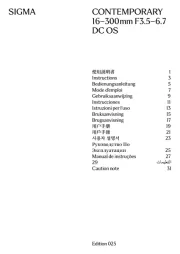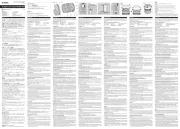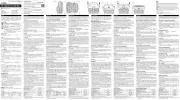Sigma 70mm f2.8 EX DG Macro Handleiding
Bekijk gratis de handleiding van Sigma 70mm f2.8 EX DG Macro (1 pagina’s), behorend tot de categorie Lens. Deze gids werd als nuttig beoordeeld door 78 mensen en kreeg gemiddeld 4.3 sterren uit 39.5 reviews. Heb je een vraag over Sigma 70mm f2.8 EX DG Macro of wil je andere gebruikers van dit product iets vragen? Stel een vraag
Pagina 1/1

Thank you very much for purchasing a Sigma Lens. In order to get the maximum
performance and enjoyment out of your Sigma lens, please read this instruction
booklet thoroughly before you start to use the lens.
DESCRIPTION OF THE PARTS (fig.1)
NIKON AF TYPE CAMERAS
This Lens functions same as a G Type (type without Aperture) auto-focus Nikon lens.
Depending on the combination with camera some restrictions with its functions may result.
For more details, please refer to instruction manual of the camera in use etc.
PENTAX AF TYPE CAMERAS
This Lens functions same as a FAJ Type (type without Aperture) auto-focus Pentax lens.
Depending on the combination with camera some restrictions with its functions may result.
For more details, please refer to instruction manual of the camera in use etc.
ATTACHING TO CAMERA BODY
When this lens is attached to the camera body it will automatically function in the same way
as your normal lens. Please refer to the instruction booklet for your camera body.
◆ On the lens mount surface, there are a number of couplers and electrical contacts.
Please keep them clean to ensure proper connection. To avoid damaging the lens, be
especially sure to place the lens with its front end down while changing the lens.
SETTING THE EXPOSURE MODE
The sigma lens functions automatically after mounting to your camera. Please, refer to the
camera instruction book.
FOCUSING
《 》Auto Focus
When you use the AF lens with the AF camera body, Auto Focusing is possible. Select the
autofocus mode on your camera body (set the focus mode switch on the lens to “AF” for
Sigma SA and Canon AF lens). In the autofocus mode, your camera will set the focus
automatically. While auto focusing, please do not touch the focus ring around the lens.
◆ To avoid damaging AF mechanism, please do not turn the focus ring manually while in
the autofocus mode.
《 》Manual Focus
You can set the focus by turning the focus ring. When you focus manually with AF lens,
select the manual focus mode on your camera body (set the focus mode switch on the lens
to “M” for Sigma SA and Canon AF lens).
◆ The viewfinder of some Nikon AF cameras have indicators to display the focus status.
The “●” symbol indicates that correct focus has been set, “►” indicates that focus is
set in front of the subject, and “ ” indicates that focus is set behind the subject. When ◄
this AF lens is used with Nikon AF cameras in MF mode, please adjust the lens’ focus
until the “●” symbol is visible.
◆ When operating this lens in manual focus mode, it is recommended that correct focus be
confirmed visually in the viewfinder rather than relying on the distance scale. This is
due to possible focus shift resulting from extreme changes in temperature which cause
various components in the lens to expand and contact. Special allowance is made for
this at the infinity setting.
FOCUS LIMITER SWITCH
This lens has a Focus Limiter switch (fig.2). When the Limiter is set at “FULL” position, the
focus ring can turn between the minimum focusing distance and the infinity position.
When the Limiter is set at “LIMIT” position, the focus ring can turn either at “close range”
(between minimum distance and 0.48m) or at “normal range” (between 0.55m and infinity).
MAGNIFICATION
The indication of the lens as “1:xx” on a focusing distance scale represent the magnification
(commonly called the reproduction ratio). For example when you are in focus at the
“1:1.5” position on the scale, a subject with an actual size of 1.5cm will have an image size
of 1cm on the firm. (fig.3)
EXPOSURE COMPENSATION
The F-number of the macro lens changes when focusing due to the extension of the lens
barrel and SLR type camera body automatically compensates it. When you use an external
light meter or a non-TTL type flash unit, you need to make exposure compensation at close
distance. (tab.6)
LENS HOOD
A bayonet type detachable hood is provided with the lens. This lens hood helps to prevent
flare and ghosted images caused by bright illumination from outside the picture area.
Attach the hood and turn clockwise until it stops rotation. (fig.4)
◆
When taking photographs using the built-in flash, it is advisable to remove the lens hood so
as to avoid cutting off any of the flash output, which could cause a shadow in the picture.
DEPTH OF FIELD SCALE
The depth of field scale helps you to check the depth of field (the zone of sharpness) of
your composition. (fig.5)
FILTER
◆ Only one filter should be used at the time. Two or more filters and/or special thicker
filters, like a polarizing filter, may cause vignetting.
◆ When using a polarizing filter with AF camera, use the “circular” type.
BASIC CARE AND STORAGE
◆ Avoid any shocks or exposure to extreme high or low temperatures or to humidity.
◆ For extended storage, choose a cool and dry place, preferably with good ventilation. To
avoid damage to the lens coating, keep away from mothballs or naphthalene gas.
◆
Do not use thinner, benzine or other organic cleaning agents to remove dirt or finger prints
from the lens elements. Clean by using a soft, moistened lens cloth or lens tissue.
◆ This lens is not waterproof. When you use the lens in the rain or near water, keep it
from getting wet. It is often impractical to repair the internal mechanism, lens elements
and electric components damaged by water.
◆ Sudden temperature changes may cause condensation or fog to appear on the surface
of the lens. When entering a warm room from the cold outdoors, it is advisable to keep
the lens in the case until the temperature of the lens approaches room temperature.
TECHNICAL SPECIFICATIONS
Lens construction 9 – 10
Angle of View 34.3°
Minimum Aperture 22
Minimum Focusing Distance 0.257m (0.843ft)
Magnification 1:1
Filter Size 62mm
Dimensions Dia.×Length 76×95mm (2.99×3.74 in)
Weight 525g (18.5 oz)
Dimensions and weight include the SIGMA mount.
(tab.6)
Magnification Distance F-No. Compensation
1 : 5 0.489m F3.3 + 0.4EV
1 : 3 0.360m F3.6 + 0.7EV
1 : 2 0.301m F3.9 + 0.9EV
1 : 1.5 0.275m F4.2 + 1.2EV
1 : 1.3 0.267m F4.5 + 1.3EV
1 : 1.1 0.260m F4.8 + 1.5EV
1 : 1 0.257m F5.0 + 1.6EV
The CE Mark is a Directive conformity mark of the European
Community (EC).
SIGMA (Deutschland) GmbH Carl-Zeiss-Str. 10/2, D-63322 Rödermark, F.R.GERMANY
Verkauf: 01805-90 90 85-0 Service: 01805-90 90 85-85 Fax: 01805-90 90 85-35
Filter Attachment Thread
Focus Ring
Distance Scale
Depth of Field Read Out Index
Focus Limiter
⑥ Focus Index Line
⑦ Focus Mode Switch
(Sigma SA and Canon AF only)
⑧ Mount
⑨ Lens Hood
ENGLISH
Product specificaties
| Merk: | Sigma |
| Categorie: | Lens |
| Model: | 70mm f2.8 EX DG Macro |
| Kleur van het product: | Zwart |
| Gewicht: | 525 g |
| Diameter: | 95 mm |
| Lensstructuur (elementen/groepen): | 10/9 |
| Lengte: | 93.98 mm |
| Dichtstbijzijnde focus afstand: | 0.257 m |
| Maximum aperture number: | 22 |
| Vergroting: | 1 x |
| Maat filter: | 62 mm |
| Aantal diafragma bladen: | 9 |
Heb je hulp nodig?
Als je hulp nodig hebt met Sigma 70mm f2.8 EX DG Macro stel dan hieronder een vraag en andere gebruikers zullen je antwoorden
Handleiding Lens Sigma
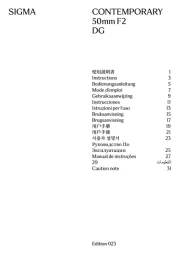
4 Juli 2025
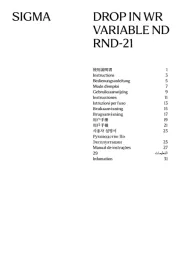
4 Juli 2025
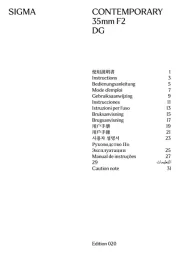
3 Juli 2025
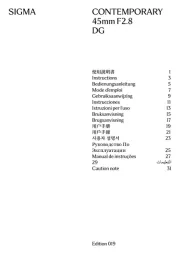
2 Juli 2025

4 Mei 2025
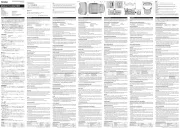
21 April 2025
Handleiding Lens
- Canon
- Godox
- Optoma
- Angénieux
- ECS
- ARRI
- Tamron
- TTArtisan
- Lensbaby
- COLBOR
- Olympus
- Viltrox
- Sensei
- Aputure
- Pelco
Nieuwste handleidingen voor Lens
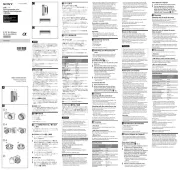
29 Juli 2025
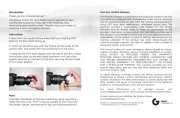
29 Juli 2025
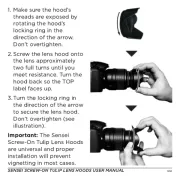
29 Juli 2025

29 Juli 2025

29 Juli 2025

29 Juli 2025

29 Juli 2025
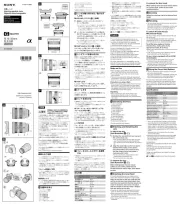
28 Juli 2025

28 Juli 2025
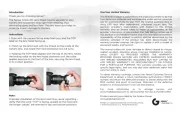
28 Juli 2025
